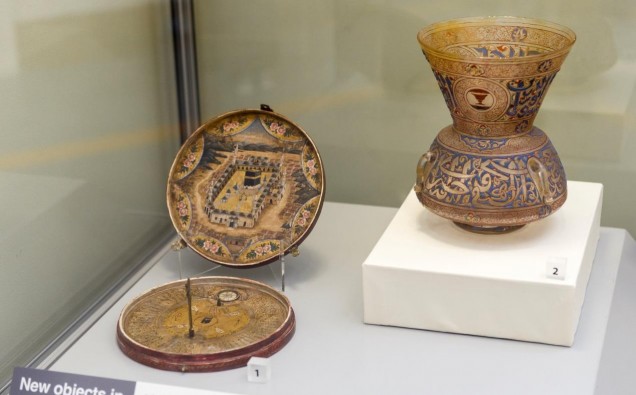Two new acquisitions of Islamic artefacts take pride of place at the heart of new displays in the Faith in Birmingham Gallery at Birmingham Museum & Art Gallery, following a multi-faith launch event held recently.
The gallery was created with people of faith from the city and the aims to provide a place where their faiths can be explored. Birmingham is one of the most ‘faithful’ of UK cities, with almost 75% of its residents identifying with a faith. The gallery originally opened in February 2016, and features artefacts and representation of faith groups who make their home in the city.
Over the six months, with direct involvement from different communities displays in the gallery have evolved. New exhibits expand the number of faith groups covered from six to 11 – Bahá’i, Jain, Mandaean, Pentecostal Christian and Rastafari joining displays relating to the Buddhist, Christian, Hindu, Jewish, Muslimand Sikh faiths.
At the heart of the displays relating to the Muslim faith are two beautiful new acquisitions of Islamic Art. These replace an earlier display of pages from one of the world’s oldest surviving copies of the Qur’an, which were loaned from the University of Birmingham’s Cadbury Research Library. When they were returned, curators worked closely with local Muslim communities to find other significant objects which would both reflect their faith, and encourage new visitors to the museum. Particularly, when a selection of Islamic art that relates to faith practice was placed up for auction at Christie’s London, worshippers at Birmingham Central Mosque offered their views of items they would like to see on display.
“With funds from the Heritage Lottery Fund, advice from Christie’s and support from the art dealer, Simon Ray, we were able to bid on a number of items, and secured two stunning artefacts to join our collections: an Ottoman Qibla indicator, and an accurate 19 th century French replica of a 14 th century Egyptian glass lamp,” comments curator of Islamic and South Asian Art, Dr Rebecca Bridgman.
“These are significant because they represent the most popular objects selected by worshippers at the Birmingham Central Mosque but also represent Birmingham’s first purchase of Islamic Art for over a century. The Qibla indicator is one of the best examples on public display in this country whilst the lamp is a wonderful example of Islamic art being deliberately imitated in Europe – a connection between different cultures. The lamp is possibly a copy of a 14 th century object held by the Metropolitan Museum in New York.”
The Qibla indicator is an instrument used by Muslims to ascertain the direction they should face for their prayers, recited five times each day – a forerunner of the compass app used today! The example acquired for the Faith in Birmingham exhibition includes a sundial, and features a beautiful painting of Mecca on both the inside of the base and lid. It dates to the 18 th or early 19 th century and was probably made in Istanbul.
Other key items on display in the Faith in Birmingham Gallery include the Sultanganj Buddha – a constant attraction at the museum for over 130 years – which is particularly revered by the local Buddhist community. New items which have been donated or lent to the museum for the gallery include a Bahá’i marriage certificate, a t-shirt belonging to a local Rastafari child, Holy books and the uniform of a Christian Street Pastor.
Birmingham Museum & Art Gallery is open from 10.00am to 5.00pm Saturday-Thursday, and 10.30am-5.00pm on Fridays, and is free entry.


















